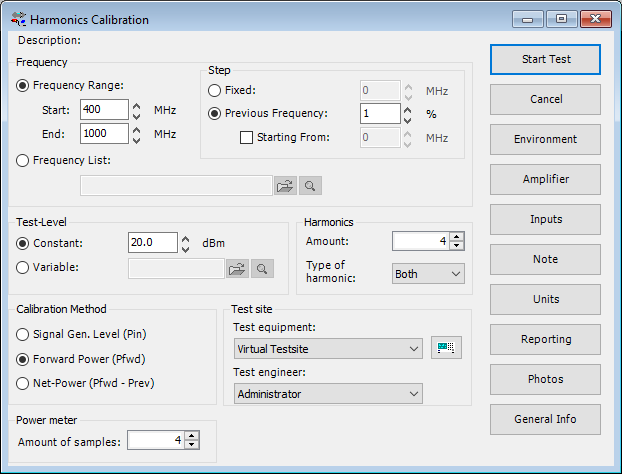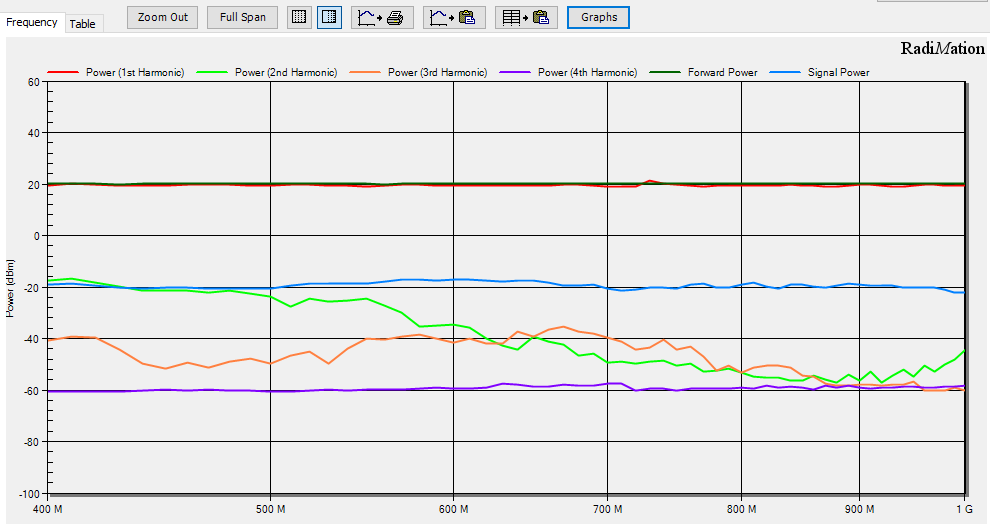RadiMation Application Note 115: Difference between revisions
| Line 7: | Line 7: | ||
The first harmonic is the same as the generated CW signal which is the input signal for the amplifier. The second harmonic is present at 2x the CW frequency. The third harmonic is present at 3x the CW frequency, and so on. | The first harmonic is the same as the generated CW signal which is the input signal for the amplifier. The second harmonic is present at 2x the CW frequency. The third harmonic is present at 3x the CW frequency, and so on. | ||
As the harmonics are thus present on higher frequencies than the CW signal, all the equipment that is | As the harmonics are thus present on higher frequencies than the CW signal, all the equipment that is connected to the output of the [[amplifier]] up to and including the used [[spectrum analyser]] should be able to be used on those higher frequencies. For an amplifier of 80 MHz - 1000 MHz, measuring up to the 6th harmonic, it is thus necessary that the measurement equipment is usable up to 6 GHz. | ||
== Overview == | == Overview == | ||
Revision as of 12:52, 24 June 2022
How to measure amplifier harmonics using RadiMation[edit]
This application note explains how RadiMation® can be used to perform accurate measurement of the harmonics that are generated by an amplifier.
The measurement of the harmonics is often needed to ensure that the used amplifier in the amplifier setup is not generating too much power on multiples of the carrier frequency.
The first harmonic is the same as the generated CW signal which is the input signal for the amplifier. The second harmonic is present at 2x the CW frequency. The third harmonic is present at 3x the CW frequency, and so on.
As the harmonics are thus present on higher frequencies than the CW signal, all the equipment that is connected to the output of the amplifier up to and including the used spectrum analyser should be able to be used on those higher frequencies. For an amplifier of 80 MHz - 1000 MHz, measuring up to the 6th harmonic, it is thus necessary that the measurement equipment is usable up to 6 GHz.
Overview[edit]
There are two possible setups of the used equipment to measure amplifier harmonics.
- Measure the initial power on the first harmonic and the additional harmonics with a spectrum analyser.
- Measure the initial power with a broadband power meter and measure the harmonics with a spectrum analyser.
A schema of the test setup:
Configuring the testsite[edit]
Using a spectrum analyser[edit]
To use only the spectrum analyser we need to configure the the Forward power meter to be the spectrum analyser device driver in the testsite. Keep in mind to not select any device for the sensor power meter on the second tab.
File:Harmonics Configure Spectrum analyser as power meter.PNG
Using a broadband powermeter and a spectrum analyser[edit]
When using the powermeter to setup the required testlevel and a spectrum analyser to measure the harmonics we need to setup the forward power meter to the power meter and on the devices 2 tab we select the spectrum analyser.
File:Harmonics Configure Broadband power meter.PNG
File:Harmonics Configure Spectrum Analyser as Sensor Power meter.PNG
Configuring the calibration[edit]
To start the harmonics calibration first, open an EUT file and select from the menu:
-
 Calibration
Calibration
-
 EUT Calibration
EUT Calibration
-
 Harmonics
Harmonics
-
-
-
The configuration window for the harmonics calibration will be shown, which allows to configure all the parameters.
Test results[edit]
In the test results it is possible to show the forward power measured. When only a spectrum analyser is used, the forward power will be the same as the first harmonic. When also a broadband power meter is used, the forward power measurement will be the measured broadband power, and it thus will be higher than the power of the first harmonic alone.
For more information on how to perform the measurement of amplifier harmonics, please see the EUT Harmonics section in Chapter 12 of the RadiMation® manual.

